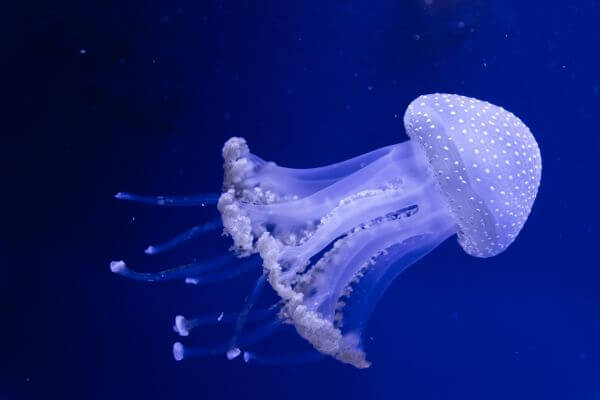The jellyfish is an exuberant animal and at the same time feared by most people. The beauty of their colors and shapes hides an invisible danger: the poisons they produce. These poisons can cause severe pain, nausea, paralysis and even lead to death in extreme cases. This article aims to analyze the most venomous species of jellyfish and the types of venom they produce.
As well as exploring how poisons are composed and how they act in the human body, knowing the importance of this information for the development of antidotes and treatments for jellyfish stings. How they use their venoms to capture prey and defend themselves against “predators”, and what care is needed after a sting, how to avoid an attack, and finally, how the overpopulation of jellyfish species is impacting the marine ecosystem.

The Jellyfish’s Lethal Dance: How Their Venoms Work
Jellyfish produce a wide variety of venoms that vary in composition and intensity. Most venoms are made up of toxic proteins and peptides, which are capable of affecting the nervous system and causing a variety of symptoms in humans and other animals that come into contact with them. Some of the snake venoms also contain enzymes that can digest living tissue, which can lead to cell destruction and the death of affected organisms.
They use their venoms to capture prey and defend themselves against predators. They have specialized cells called cnidocytes in their tentacles, which contain tiny darts or harpoons that are loaded with venom. When an animal comes into contact with the jellyfish’s tentacles, these cnidocytes are activated and the darts are launched towards the target.
Venom is injected into the animal, paralyzing or killing it. Some species are also capable of releasing their entire tentacles as a defensive strategy. The tentacles float in the water and can be mistaken for prey by other animals, which are then poisoned when they come into contact with them.
Jellyfish Sting: Understand the Human Body’s Reactions to Toxins
A jellyfish sting can be an extremely painful and unpleasant experience for anyone who has contact with these marine animals. When the tentacles come into contact with human skin, they release a poisonous toxin that can cause a variety of symptoms, from severe pain to paralysis, or even death in extreme cases.
The reactions of the human body when coming into contact with toxins vary according to the species of jellyfish involved, the amount of toxin present in the tentacles and the individual sensitivity of each person. The most common symptoms include severe pain, redness, swelling, itching and a burning sensation on the skin.
In more severe cases, difficulty breathing, nausea, vomiting, disorientation, and loss of consciousness may occur. It’s important to note that some people may be more susceptible to the effects of the toxins than others, and may experience more severe or persistent symptoms after being bitten.
First Aid In Case Of Sting: What to do to relieve pain and minimize damage?
If you are stung by a jellyfish, it’s important to act quickly to minimize symptoms and avoid complications. First, get out of the water immediately and wash the affected area with salt water or saline to remove tentacles and toxins. Do not use fresh water, as this can make the pain and inflammation worse.
Then apply vinegar to the affected area for at least 30 seconds. Vinegar helps to neutralize toxins and prevent them from spreading throughout the body. Afterwards, you can use a cold compress to ease the pain and inflammation. In more severe cases, seek medical attention right away, especially if you experience difficulty breathing, chest pain, or other serious symptoms.
If possible, take a sample of the jellyfish tentacle for species identification and better treatment. In some cases, it may be necessary to use medications or even specific antidotes.
Lethal Huntresses: The 4 Most Dangerous Jellyfish Species
The most dangerous species in the world are:
- Box jellyfish (Chironex fleckeri): Found in the coastal waters of Australia and the Indian Ocean, it is considered the most venomous in the world. Its tentacles can measure up to 3 meters in length and contain toxins that affect the nervous system, which can cause paralysis and lead to death within minutes.
- Irukandji jellyfish (Carukia barnesi): Found in Australia, Indonesia and the Philippines, it is small and measures about 2.5 centimeters, but its venom is extremely potent. Symptoms can include severe pain, nausea, vomiting and even heart problems, which can lead to death in extreme cases.
- Box jellyfish (Malo kingi): Found in coastal waters of New Zealand and Australia, its sting can cause severe pain, nausea, vomiting, sweating, difficulty breathing and heart problems.
- Wasp Jellyfish (Physalia physalis): Found in the tropical waters of the Atlantic, Pacific, and Indian Oceans, this species is not technically a jellyfish, but rather a colony of individual organisms called hydroids. Its tentacles can measure up to 50 meters in length and contain poison that causes intense pain, burning and redness of the skin.
Each of these species can cause severe symptoms and even death in extreme cases, highlighting the importance of taking precautions when swimming or coming into contact with waters where these species may be present.
The Latest Research on Combating Poisons
The most recent research on combating jellyfish venoms has focused on finding more effective and safer solutions for treating people who suffer from jellyfish stings. One of the promising approaches is the development of specific antidotes that can neutralize the toxins. These antidotes are produced by immunizing animals, such as horses, which receive small doses of the venom and develop antibodies in response. These antibodies are then collected and purified to be used as antidotes in humans.
Another line of research that is being explored is the identification and isolation of the venom’s individual components, so that they can be studied in detail and used as a basis for the development of new drugs and therapies. This approach has shown promising results, as the venoms contain a wide variety of bioactive compounds with the potential to treat a variety of diseases, including chronic pain, autoimmune diseases and even cancer.
The Imbalance of Marine Ecosystems
Factors affecting jellyfish populations include climate change, which increases water temperature and salinity, overfishing, and pollution. In addition, the reduction in the population of natural predators, such as sea turtles and fish, contributes to the increase in the population of these animals. Human activities such as oil rigs, tourism in coastal areas and the introduction of invasive species also impact the growth of these populations, providing breeding and feeding areas or competing for resources.
Some studies suggest that changing populations of jellyfish could have cascading effects on marine ecosystems, affecting the food chain and the species that depend on these animals. Understanding the dynamics of jellyfish populations and the interactions between the animals and their environment is important for the sustainable management of the oceans and for minimizing negative impacts on marine ecosystems.
In short, with the growth of the population of these animals, there has been an increase in the number of attacks on humans in different parts of the world, which has become a growing concern for safety on beaches and bathing areas. In order not to run the risk of being attacked by jellyfish, avoid swimming in areas known to have a high concentration of these animals and wear appropriate clothing for protection.

